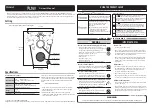
23
Balancing the SeaOtter-2
The SeaOtter-2 was designed for ease of operation, however, prior to its use it must be balanced and
it’s buoyancy adjusted for it to perform correctly. Proper balance is very important in order to insure
proper flight characteristics. If the SeaOtter-2 is nose heavy, it will dive as it goes forward; and if it
has a heavy side, it will exhibit unstable side motion characteristics. If it’s buoyancy is too positive it
will be difficult to drive underwater without it coming to the surface. If it’s balance is correct, it will float
level in the water. If it’s buoyancy is correct, the water line will be just above the top of the body..
Buoyancy is correct
Nose too heavy
Water line
Too positive buoyant
Water line
Front to Rear
Balance is correct
Water Operation:
The SeaOtter-2 comes equipped with ballast lead installed in the skids. Additional small "fine
balancing" weights are also included in the SeaOtter's shipping box. In order to properly "fine tune"
the balance and buoyancy of the SeaOtter, you must first place it in the water with the cable attached
and the buoyancy collar over the in-line connector. Be sure to be in the same kind of water (fresh/salt)
as where you will be operating it. The SeaOtter-2 should submerge to an almost neutrally buoyant
state, evenly balanced from side to side, and front to rear. When properly balanced, the SeaOtter-2
should be slightly positive buoyant.
Skids
123456789012345
123456789012345
123456789012345
123456789012345
123456789012345
1234567
1234567
1234567
1234567
1234567
1234567
1234567
1234567
1234567
Legs
Center
ballast weight
Spacers
123
123
123
123
123
123
123
123
123
123
1234
1234
1234
1234
1234
1234
1234
1234
1234
1234
Skid
cones
Trim weights
Snap
rings
Skid
Summary of Contents for SeaOtter-2
Page 11: ...11 Left Blank...







































